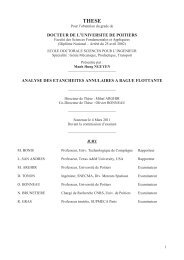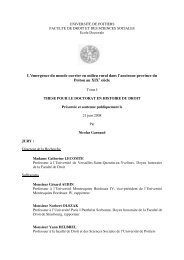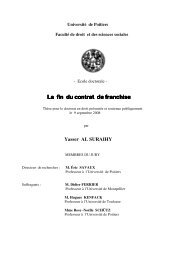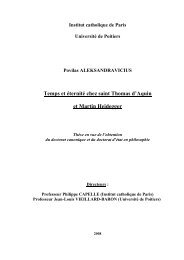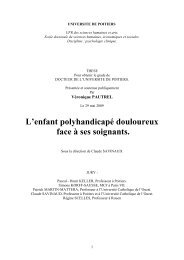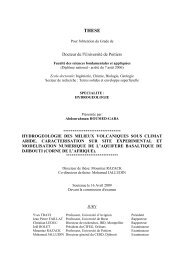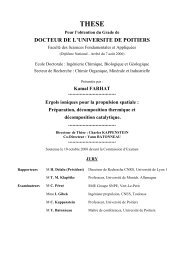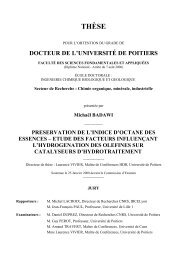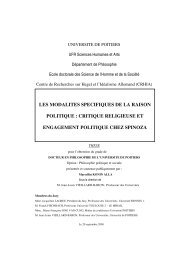- Page 1:
THESE Pour l’obtention du Grade d
- Page 5 and 6:
Remerciements L’homme est un éte
- Page 7 and 8:
Remerciements Il va s’en dire que
- Page 9 and 10:
Table des matières La théorie, c
- Page 11 and 12:
Table des matières REMERCIEMENTS I
- Page 13 and 14:
Table des matières A.10. ARTICLE A
- Page 15 and 16:
Introduction Serons-nous capables d
- Page 17 and 18:
Introduction Le contrôle d’écou
- Page 19 and 20:
Introduction également des notions
- Page 21 and 22:
- L’actionneur plasma - - 7 -
- Page 23 and 24:
1. Revue bibliographique sur les d
- Page 25 and 26:
1. Revue bibliographique sur les d
- Page 27 and 28:
1. Revue bibliographique sur les d
- Page 29 and 30:
1. Revue bibliographique sur les d
- Page 31 and 32:
1. Revue bibliographique sur les d
- Page 33 and 34:
1.3. Le vent électrique 1. Revue b
- Page 35 and 36:
f j 1. Revue bibliographique sur le
- Page 37 and 38:
. Propriétés électriques 1. Revu
- Page 39 and 40:
Y (mm) 16 14 12 10 8 6 4 2 0 1. Rev
- Page 41 and 42:
1. Revue bibliographique sur les d
- Page 43 and 44:
1. Revue bibliographique sur les d
- Page 45 and 46:
1. Revue bibliographique sur les d
- Page 47 and 48:
1. Revue bibliographique sur les d
- Page 49 and 50:
Figure 1.24. Cycle de fonctionnemen
- Page 51 and 52:
1. Revue bibliographique sur les d
- Page 53 and 54:
2. Optimisation du vent induit par
- Page 55 and 56:
2. Optimisation du vent induit par
- Page 57 and 58:
2. Optimisation du vent induit par
- Page 59 and 60:
2. Optimisation du vent induit par
- Page 61 and 62:
(a) (b) 2. Optimisation du vent ind
- Page 63 and 64:
2. Optimisation du vent induit par
- Page 65 and 66:
(a) (b) 2. Optimisation du vent ind
- Page 67 and 68:
2. Optimisation du vent induit par
- Page 69 and 70:
3. Développement d’un actionneur
- Page 71 and 72:
3. Développement d’un actionneur
- Page 73 and 74:
3. Développement d’un actionneur
- Page 75 and 76:
3. Développement d’un actionneur
- Page 77 and 78:
3.2. Étude de la forme d’onde du
- Page 79 and 80:
3. Développement d’un actionneur
- Page 81 and 82:
3. Développement d’un actionneur
- Page 83 and 84:
3. Développement d’un actionneur
- Page 85 and 86:
3. Développement d’un actionneur
- Page 87 and 88:
3.4.2. Influence d’une bobine sur
- Page 89 and 90:
3. Développement d’un actionneur
- Page 91 and 92:
3. Développement d’un actionneur
- Page 93 and 94:
3. Développement d’un actionneur
- Page 95 and 96:
- Application au contrôle - - 81 -
- Page 97 and 98:
4. Revue bibliographique sur le con
- Page 99 and 100:
4. Revue bibliographique sur le con
- Page 101 and 102:
4.1.2. Transition Laminaire - Turbu
- Page 103 and 104:
. Décollement inertiel 4. Revue bi
- Page 105 and 106:
4. Revue bibliographique sur le con
- Page 107 and 108:
4.3.1. Écoulement de plaque plane
- Page 109 and 110:
4. Revue bibliographique sur le con
- Page 111 and 112:
4. Revue bibliographique sur le con
- Page 113 and 114:
4. Revue bibliographique sur le con
- Page 115 and 116:
4. Revue bibliographique sur le con
- Page 117 and 118:
5. Contrôle du point de séparatio
- Page 119 and 120:
5. Contrôle du point de séparatio
- Page 121 and 122:
corps principal en bois 5. Contrôl
- Page 123 and 124:
5. Contrôle du point de séparatio
- Page 125 and 126:
5. Contrôle du point de séparatio
- Page 127 and 128:
5. Contrôle du point de séparatio
- Page 129 and 130:
5. Contrôle du point de séparatio
- Page 131 and 132:
5. Contrôle du point de séparatio
- Page 133 and 134:
5. Contrôle du point de séparatio
- Page 135 and 136:
5. Contrôle du point de séparatio
- Page 137 and 138:
6. Contrôle des décollements sur
- Page 139 and 140:
6. Contrôle des décollements sur
- Page 141 and 142:
6. Contrôle des décollements sur
- Page 143 and 144:
6. Contrôle des décollements sur
- Page 145 and 146: 6. Contrôle des décollements sur
- Page 147 and 148: 6. Contrôle des décollements sur
- Page 149 and 150: 6. Contrôle des décollements sur
- Page 151 and 152: 6. Contrôle des décollements sur
- Page 153 and 154: 6. Contrôle des décollements sur
- Page 155 and 156: 6. Contrôle des décollements sur
- Page 157 and 158: 6. Contrôle des décollements sur
- Page 159 and 160: Conclusions et perspectives On ne f
- Page 161 and 162: Conclusions et perspectives Les tra
- Page 163 and 164: Conclusions et perspectives Par la
- Page 165 and 166: Conclusions et perspectives Une voi
- Page 167 and 168: Annexes La science est peut être l
- Page 169 and 170: A.1. Principe de la mesure de la pe
- Page 171 and 172: A.2. Influence de l’épaisseur du
- Page 173 and 174: Annexes Figure A.2.6. Évolution du
- Page 175 and 176: A.3. Étude de la forme d’onde du
- Page 177 and 178: Figure A.3.6. Évolution du rendeme
- Page 179 and 180: A.4. Approche non conventionnelle p
- Page 181 and 182: A.5. Vélocimétrie par imagerie de
- Page 183 and 184: Annexes _ Le plus pic le plus impor
- Page 185 and 186: A.6. Application du contrôle sur l
- Page 187 and 188: Annexes Figure A.6.4. Profils de vi
- Page 189 and 190: A.7. Plan technique du NACA 0015-Ei
- Page 191 and 192: A.8. Correctifs apportés sur les c
- Page 193 and 194: A.9. Influence du rapport cyclique
- Page 195: A.10. Article AIAA Paper 2008-4202
- Page 199 and 200: Annexes field for baseline flow con
- Page 201 and 202: Annexes to the flow fluctuations wh
- Page 203 and 204: Annexes however the actuation is no
- Page 205 and 206: Annexes flow is reattached at x/C
- Page 207 and 208: Annexes E. Control Process Scenario
- Page 209 and 210: Annexes function reveals that a nat
- Page 211 and 212: Bibliographie Une vérité cesse d
- Page 213 and 214: Bibliographie [1] Hefner JN, 1988,
- Page 215 and 216: Bibliographie [40] Pons J, Moreau E
- Page 217 and 218: Bibliographie [73] Moreau E, Léger
- Page 219 and 220: Bibliographie [108] Post ML et Cork
- Page 221 and 222: Bibliographie [141] Macheret S, “
- Page 224: ETUDE ET DEVELOPPEMENT D’UN ACTIO



